Recommended Resource – The Pocket Small Business Owner’s Guide to Negotiating
The Pocket Small Business Owner’s Guide to Negotiating
by Richard Weisgrau
About the Reference
The Pocket Small Business Owner’s Guide to Negotiating by Richard Weisgrau provides readers with a complete set of practices and strategies for successfully negotiating through numerous situations. Richard explores both the psychology and activities occurring before, during, and after a negotiation. Through his book, readers learn to:
- Differentiate between principle and positional bargaining
- Negotiate contracts, purchases, and service deals
- Resolve conflicts
- Barter
- Assess risk
- Take advantage of the psychological aspects of negotiating
- Employ rhetorical tactics and body language successfully
Benefits of Using This Reference
StrategyDriven Contributors like The Pocket Small Business Owner’s Guide to Negotiating for its thoroughness in covering a multitude of negotiating situations. We found Richard’s book a good ready reference for small business owners and large company division and department managers.
The Pocket Small Business Owner’s Guide to Negotiating covers the psychological and behavioral aspects of negotiation, both being critically important to a successful outcome. Additionally, Richard provides an easy-to-follow method for negotiation preparation, execution, and follow-up. By using the prescribed methods, readers should find their negotiations more successfully resolved.
If we had one criticism of The Pocket Small Business Owner’s Guide to Negotiating it would be that the negotiating approach seeks an equitable outcome; precluding the opportunity for overwhelmingly positive terms.
The Pocket Small Business Owner’s Guide to Negotiating provides readers with actionable steps to negotiate the situations most commonly encountered by small business and business group leaders. While not intended to inform the actions of those negotiating ‘super-deals,’ the thoroughness of the methods and real world examples conveyed makes The Pocket Small Business Owner’s Guide to Negotiating a StrategyDriven recommended read.


 Helanie (pronounced yeh-LAH-nee) Scott has driven stunning leadership and cultural transformations for an impressive list of organizations including: Dr. Pepper, Reuters, Fluor, Ericsson, PepsiCo and more.
Helanie (pronounced yeh-LAH-nee) Scott has driven stunning leadership and cultural transformations for an impressive list of organizations including: Dr. Pepper, Reuters, Fluor, Ericsson, PepsiCo and more. Since growing up in his family’s boating business to founding his company CMI, Bruce Hodes has dedicated himself to helping companies grow by developing executive leadership teams, business leaders and executives into powerful performers. Bruce’s adaptable Breakthrough Strategic Business Planning methodology has been specifically designed for small-to-mid-sized companies and is especially valuable for family company challenges. In February of 2012 Bruce published his first book
Since growing up in his family’s boating business to founding his company CMI, Bruce Hodes has dedicated himself to helping companies grow by developing executive leadership teams, business leaders and executives into powerful performers. Bruce’s adaptable Breakthrough Strategic Business Planning methodology has been specifically designed for small-to-mid-sized companies and is especially valuable for family company challenges. In February of 2012 Bruce published his first book  Since growing up in his family’s boating business to founding his company CMI, Bruce Hodes has dedicated himself to helping companies grow by developing executive leadership teams, business leaders and executives into powerful performers. Bruce’s adaptable Breakthrough Strategic Business Planning methodology has been specifically designed for small-to-mid-sized companies and is especially valuable for family company challenges. In February of 2012 Bruce published his first book
Since growing up in his family’s boating business to founding his company CMI, Bruce Hodes has dedicated himself to helping companies grow by developing executive leadership teams, business leaders and executives into powerful performers. Bruce’s adaptable Breakthrough Strategic Business Planning methodology has been specifically designed for small-to-mid-sized companies and is especially valuable for family company challenges. In February of 2012 Bruce published his first book